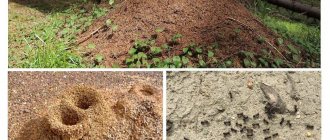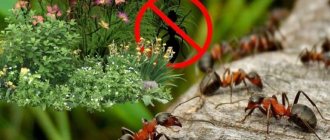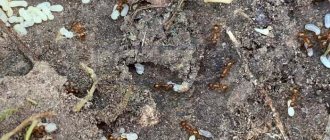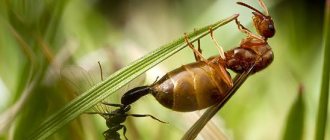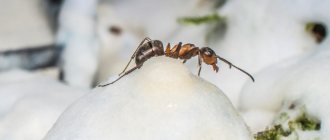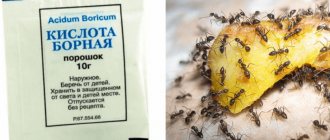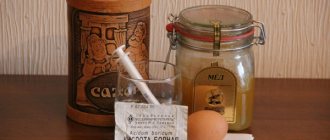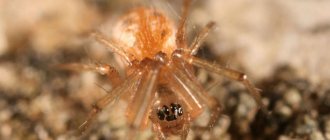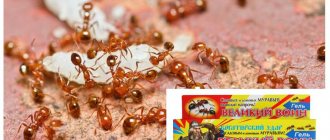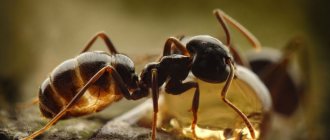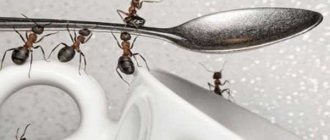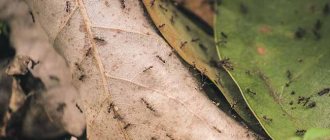Lifespan of some ant species
Pharaoh ants live shorter than others.
It is easy to guess from the name that their homeland is the hot countries of Africa. How do ants of this species live in very cool Europe? They settle next to a person. They do not build anthills; they arrange their nests in the cavities of residential buildings. It doesn’t matter whether they are wooden or concrete multi-story ones. Female pharaoh ants rarely live to an advanced age, usually not reaching a year
But they are distinguished by high fertility - in 12 months they are capable of producing several thousand individuals. Moreover, several “queens” can simultaneously coexist in the nests of pharaoh ants. Males of this species live only 20 days, worker ants - about two months.
Black garden ants also live not far from humans. They need human housing to survive the winter. Garden ant workers can live up to 3 years. Tropical ants live the longest. There is a known case where the queen of a bulldog ant lived for 28 years. But even ordinary, working ants of this species live up to 5 years.
Also, familiar to us firsthand, is the harvester ant, five of the 110 species of which live in Russia. They live in colonies of up to 5,000 individuals. These ants are perhaps the most popular species for breeding in home anthill farms - formicariums. How long do harvester ants live? Their life span consists of several stages:
- Egg 2-3 weeks
- Larva 2-3 weeks
- Cupola 2-3 weeks
- And a full-fledged worker ant that has already appeared after 1.5 - 2 months will live from 1 to 5 years, depending on living conditions. But the queen of the harvester ant (aka queen) can live up to 20 years.
When living in a formicarium in an apartment, the lifespan of an ant is reduced many times over.
Previous entry How to remove bedbugs: only proven methods in the fight against dangerous insects Next entry
A family is an association in which each individual performs only part of the functions associated with preservation and reproduction. As the ant community grows and its integrity strengthens, the division of functions becomes more profound: the number of professions of working ants increases, and the specialization of each individual narrows (to denote differences in the functions performed by ants, specialists who study ants - myrmecologists use the term polyethism *).
In some species, specialization manifested itself in the morphological differences of individuals; for example, the worker ant caste split into soldiers and workers. However, in most ants, the division of functions is not associated with morphological differences. The basis for the specialization of worker ants was their physiological state and mental tendencies. Worker ants from the same nest, very similar to each other in appearance, differ greatly from each other in age and physiological state; They are proactive and inquisitive to varying degrees. Some of them are bold and aggressive, others are timid. One ant is resourceful but impatient, the other can, like an automaton, repeat monotonous actions over and over again. Professions among the ants are distributed accordingly.
This was a prerequisite for the identification of so-called polyethic groups* within the caste of worker ants, i.e., groups of individuals engaged in performing a certain range of duties. Numerous experiments by researchers from different countries have established that ants who are more proactive and quick to react perform work related to solving various problems in non-standard situations. They become scouts or hunters. These same ants cope much worse with monotonous duties that do not require an active start. But individuals with a slow reaction and a minimum of curiosity are inclined to perform just such functions, for example, collecting honeydew (sweet secretions) from aphids. The honeydew collector walks leisurely every day along the same road to the same tree, where there is a colony of aphids on a branch. The ant sucks up the sweet droplets and, having filled its goiter, just as leisurely returns along the long-known road to the nest.
In the families of all social insects, there is a change in the work performed by the individual during its life. In most cases, such a change comes down to the mandatory transition of an insect from one profession to another as it ages, which is called age-related polyethism. Young individuals are inside the nest and care for females and young, then they dig tunnels or build cells, and after some time they become foragers and obtain food for the family.
In ants, age also affects the duties performed by the worker, but this connection is not so clear. Within a few days after emerging from the cocoon, the worker ant has the opportunity to choose a profession. Some ants look after the young, while others participate in the construction of the nest, become foragers, others clean the premises, etc. The activities of the ant in this case are not related to age. A significant part of individuals can remain in the same duties for almost their entire lives, for example, in the role of nannies or retinue of the female. Others very quickly, within a few days, undergo a kind of introductory course inside the nest and become foragers. The fixation of an individual in one function is called caste, or permanent, polyethism.
Naturally, it is not only the inclinations of individuals that determine their responsibilities in the anthill. An ant cannot live alone. Each ant is part of a large community, which contains from several hundred to several million individuals. In order for an ant family to exist successfully, each professional or functional group of individuals* in its composition must be sufficiently representative and perform their duties well. functions. Typically, most individuals are engaged in activities that largely correspond to their individual characteristics. But there are situations when the anthill suffers huge losses and mainly one of the functional groups may suffer. For example, during chemical treatments of forest plantations, all foraging ants that were on the surface at that time may die, but the workers inside the nest will not actually be harmed. And then the survivors have to change professions. A similar situation was modeled in cages by the Polish myrmecologist J. Dobzhanskaya. Experimental families were recruited from workers of any one functional group, they were given a female and larvae. The ants were forced to rebuild and perform all the work necessary for the normal existence of the family. At the same time, it was noticeable that ants recruited from one functional group did not cope with other responsibilities equally successfully. Thus, the hunter ant clumsily and very uncertainly performs the functions of a nanny. Nevertheless, in most cases, a family composed of working individuals of one functional group survived. It is clear that such situations occur extremely rarely in the life of ants and, as a rule, the abilities of an ant correspond to the functions that it performs.
The tasks facing the ants of one community are significantly different. They can be considered using the example of extra-nest foraging ants that provide food for the family. The Aralocaspian harvester ant, which collects seeds of desert plants, has two types of foragers - active and passive*. Foragers of the first type act alone in the feeding area, performing the tasks of scouts. There are few of them, no more than 3% of the total number of foragers. Each scout has an individual search area, which he knows and which he regularly surveys. Having discovered ripe seeds on the site, the scout, on the same day or the next, mobilizes thousands of ants to collect these seeds, which do not go out to forage on their own initiative. Mobilized ants belong to the second group of foragers, which in most species does not have a specific specialization and attachment to any area in the territory used by the anthill. They perform a variety of work in the nest (cleaning the nest, digging passages, etc.) and on the surface they do what individuals of the first group mobilize them to do (collecting seeds and removing husks from the anthill).
Ants of the second group do not search for prey in the territory, and when brought to it, they cannot mobilize other workers. They represent, to some extent, a permanent mobile reserve of “broad specialists”, suitable for performing several functions, but who do not have the initiative and play the role of passive performers. Therefore, we called the second group of foragers passive foragers. Accordingly, foragers of the first group, conducting an independent search, activating and mobilizing other ants to solve specific problems, will be active foragers. Extending these concepts to intra-nest workers, we can talk about active and passive individuals. Since this division is based on the individual properties of ants, these groups are polyethic, which reflects the type of activity, and not a specific function specifically. Within one polyethic group there may be several functional groups of individuals performing tasks that are different in specific content, but similar in the type of behavior of the performers.
Active and passive foragers are present in the families of most species (some species have only active foragers). The number of active and passive functional groups depends on the characteristics of the biology of the species: the size of the family and the complexity of its organization, the type of nest, etc. For example, with the appearance of a ground dome of needles and twigs, red forest ants formed a functional group of observer ants, first discovered by P .I.Marikovsky. This group includes the most experienced individuals, who mobilize the family to protect the anthill in the event of an immediate threat to the nest. In many species, nurse ants have appeared, carrying the chitin of victims and empty cocoons to the outskirts of the protected territory of the family. More specific functions have also emerged in some passive foragers of some species. This is especially clearly expressed in ants that use aphids and other insects that secrete honeydew (Fig. 1). Honeydew has become one of the main components of the diet of ants, which therefore protect aphids from enemies, resettle them and even build special shelters for them. Such an alliance (trophobiosis*) is beneficial to both parties and is ultimately accompanied by a significant increase in the number of both ants and insects associated with them.
Fig.1. Carpenter ants on an aphid colony.
Passive foragers turn into honeydew collectors and, which is of particular interest, become attached to one of the colonies of honeydew-secreting insects. Thus, constant specialization entails the territorial consolidation of ants. The type of activity of the passive forager does not change. The honeydew collector follows the same path day after day to a particular colony of aphids and back, performing monotonous work lacking initiative. For the first time, it is carried out or brought to a given colony by other ants. Moved from the road 1 m to the side, the honeydew collector may get lost; if left to his own devices, he will not find his way into the anthill at all.
Honeydew collectors always remain the family's reserve. In the event of clashes between the inhabitants of an anthill and any of its neighbors, honeydew collectors will be mobilized for “war,” while active foragers employed in other sectors of the feeding area will remain in their places. Consequently, the subordination of worker ants of two polyethic groups remains the same in different species. In the above-mentioned experiments by Ya. Dobzhanskaya, for ant families composed of individuals of one functional group, there was only one option for a non-viable family - a family including only honeydew collectors. Such families quickly died. Thus, the ants decide the dispute between “narrow” and “broad” specialists in favor of the former.
It is significant that in species that do not have a clear caste differentiation of working individuals, the function performed by the ant in the family is not related to its size. In those cases where there are clear castes or differences in size, the professions of ants are quite strongly associated with the caste or size group to which the individual belongs. Thus, steppe honey ants have large and small workers, the latter being several times smaller than the former. One of the features of these ants is the presence in their families of “honey barrels” - ants that store food for the family in the crop. The largest workers serve as “barrels”, and small individuals serve as foragers.
Against the background of the variety of professions available in the ant family and the complexity of behavior required to solve a number of problems (capturing prey, constructing a nesting dome of the correct shape, etc.), the constant polyethism that has appeared in ants acquires special significance. The ant gets the opportunity to gain experience, learn various techniques for mastering prey and fighting ants of other species, and transporting prey to the nest. He begins to easily navigate the area. All this is especially important for scouts, hunters, collectors of building material, porters, observers and other polyethic groups of active foragers. It should be noted that due to the significant life expectancy of ants (a working individual can live for several years), the accumulation of experience becomes important not only for the individual, but also for the family as a whole. Constant polyethism becomes even more important in species that hunt in groups and transport prey.
In the family there are simultaneously individuals of several generations, during the interaction of which novice foragers are trained by more experienced ones. Old ants are the keepers of information important for the life of the family. For example, in red wood ants, each forager begins its non-nesting activity on the periphery of the family’s protected territory. Subsequently, it gradually moves to individual search areas closer and closer to the nest, and this path ends at the dome, where the ant serves as an observer.
Each observer who leaves the foragers has a fairly complete understanding of one of the sectors of the protected territory of the nest. He serves in that part of the dome that is adjacent to this sector. If, as a result of some catastrophe, all the foragers currently active on one of the roads of the anthill perish, information about this area will not be lost by the family. This has been verified experimentally.
All forages were confiscated from several families of the common forest ant on one of the roads. Due to the specific organization of the community, for these ants the transition of foragers from other roads is almost impossible. Yes, it would not have solved the problem of preserving the previous structure of the territory adjacent to the experimental road, since foragers from other roads do not know it. However, in the experiment, within two to three days, the structure of the site was restored in all details. This happened thanks to the observer ants that remained on the dome, some of which, as established by tagging, returned to the territory and restored its original structure. When the ants located on the side of the dome adjacent to the experimental road were removed along with the foragers, the situation changed dramatically.
A few days later, having selected a new contingent of foragers from its composition, the family gradually regained possession of the lost part of the territory, but the original road network and many aphid colonies in the experimental sector were lost.
Under normal conditions, observer ants guarantee the restoration of the old road network - the basis of the protected territory of the ants during the spring activation of families. This is one of the reasons for the amazing constancy of the feeding routes of some species, which are renewed from year to year for many years.
In addition to the specialization of individuals within the family of each species, there is an equally diverse and clear specialization of various species of ants that have adapted to living in certain conditions. Species professions are primarily associated with the food specialization of ants. The type of nutrition largely determines the lifestyle of ants and the professions of workers in the community, as well as the ratio of polyethic and various functional groups. Granivorous species build nests with a specific structure and have characteristic cycles of foraging activity, timed to coincide with the maturation of seeds of various plants. These are usually quite slow, peaceful, even timid ants. They have developed a system of mass mobilization of passive foragers by a few scouts. There are few of the latter, since they are not searching for an individual grain, but for large areas with a ripened harvest of seeds, for which numerous scouts are not needed.
Predatory ants, on the contrary, are distinguished by their aggressive disposition, quick reaction and high mobility of foragers. Active individuals predominate here, often acting alone at a considerable distance from the nest. For example, in one of the Australian bulldog ants, solitary hunters in search of prey go away from the nest at a distance of up to 2 km. The greatest diversity of functional groups is found in polyphagous ants, which consume a variety of foods. There is also a relatively balanced ratio of passive and active foragers in the nests.
In polyphagous species, the highest constant dynamic density of individuals* in the feeding area is achieved, and therefore the value of mobilization in these ants decreases.
The “professional appearance” of ants is also formed during the adaptation of the species to specific living conditions. Many striking examples of this are provided by extreme living conditions, in particular the desert. For example, one of the main activities outside the nest of the pallid runner, which lives on shifting sands, is shoveling sand from the entrance to the anthill. This is constantly done by successive groups of working individuals.
For the successful existence of an ant community, it is necessary to have all the specializations (professions) characteristic of this type and the optimal ratio of representatives of various professions for specific conditions. Ants have a variety of opportunities to quickly control and regulate the composition of the anthill, which ensures high resilience and plasticity of the community, the ability to actively resist adverse environmental changes and stabilize numbers. This is inaccessible to most other insects.
| The attachment | Size |
| 10.78 KB |
‹ Family composition Up Interaction of ants in a family ›
How does an ant colony work?
The social hierarchy within an ant colony is often compared to the structure of a bee hive. These two species are similar in many ways, but the behavior of ants is still much more complex. Just like in human society, these insects have a strict division into classes. The anthill is designed in such a way that each mature individual has its own purpose.
Depending on a set of certain qualities, each insect is assigned to one or another social post. In this case, the personal qualities of the individual are taken into account - excessive aggressiveness, keen sense of smell, reaction speed. The hierarchy of any anthill contains the following categories of individuals:
- invaders - the most aggressive group in the anthill, attacks neighboring colonies, seizes territories,
- orderlies - isolate sick and wounded ants, if necessary, play the role of surgeons - the damaged limb is often amputated (gnawed off),
- builders are one of the largest social groups. They are engaged in repairs of premises and the external covering of the home. Throughout their life, they dig new tunnels, transport needles and twigs, maintain the microclimate inside the anthill,
- nannies - take care of the offspring, from the appearance of the egg to the adulthood of the individual. They are constantly close to the larvae, turn them over, control the process of hatching from eggs and feed the growing offspring,
- guards - are engaged in guarding the entrances and exits of the anthill; in the event of an attack, they attack the enemy and do not allow him to get inside the dwelling. Among this category there are the most losses; attacks on neighbors are common for neighboring colonies. In addition, birds and some animals like to feast on ants, and the guards never leave their posts, protecting the entrance to the last.
- foragers. The largest group in the colony. Their mission is to obtain food for the entire anthill. Every day, miners go in search of food - grass seeds, dead and weakened insects, fruits and berries. If one ant finds a large insect (caterpillar, beetle), then with the help of special signals it communicates with its fellow tribesmen, “telling” about the prey. With their combined efforts, insects can even drag a dead rodent. Attacks often occur on weakened or wounded bees, worms, and mice. From numerous bites the victim dies and becomes food for the colony,
- shepherds. Another amazing feature of these insects is that they have peculiar pets. Herbal aphids feed on plants, and the liquid released in the process - honeydew - is collected by ants. This liquid is a waste product of aphids, has a sweetish taste and serves as a kind of delicacy for insects. The carbohydrates contained in honeydew provide the ants with energy. Therefore, aphids are collected into peculiar “herds” and protected in every possible way (for example, from theft by ants from neighboring colonies). To increase the amount of honeydew, shepherds tickle the bellies of their cows, stimulating the production of a valuable substance,
- carriers - work together with shepherds, their main task is to carry honeydew into special chambers. If necessary, engage in battle with the invaders,
- storekeepers - responsible for maintaining supplies inside the cells. They monitor the maintenance of temperature conditions and the safety of supplies. The life of the colony during the winter months depends on them, since proper conservation of food resources ensures the prosperity of the anthill,
Depending on the habitat, special “professions” appear. For example, leaf-cutter ants living in forests collect leaves from certain trees and plants. Afterwards they are transferred to the anthill, twisted in a special way and used to grow mushrooms, which are one of the main products in their diet.
Interesting fact: in some species, the profession is genetically predetermined, which is reflected in the structure of the ant’s body. And in other species, the profession is acquired by individuals gradually and they are able to replace each other’s functions if necessary.
Wintering
How ants live in cold weather is also interesting. From mid-summer they make food reserves for the winter. With the first frost, all entrances are tightly closed. As the temperature drops, they move to the lower part of the anthill.
Anthill in winter If winter is not so severe, life inside does not stop. Everything goes on as usual, only the female’s fertility decreases. Insects even have the ability to go outside in search of food. During severe frosts, ants move to bedrooms. Their metabolism slows down, the need for nutrition disappears, and the insect stops moving. People characterize this state as deep sleep.
Life in the anthill becomes more active with the onset of warm weather. The soil warms up, the ants gradually move to the upper floors and open the entrances.
Ant Society
The structure of the “social life” of an anthill is even more complex than the structure of life in a hive. Ants are a lot like people. For example, slavery is common in some species. Ants attack someone else's anthill and steal the pupae. Having then grown up in someone else's anthill, the captives work for its benefit. It would seem, what kind of slavery, when the unfortunate workers do nothing but selflessly work for the benefit of the queen and the males all their lives. But usually ants work for the prosperity of their own species and their own colony. By the way, huge Amazon ants specialize only in “military actions”: only stolen slaves work for the benefit of the anthill.
There is a more sophisticated way to seize power. There are species of ants whose female can literally charm ants of another species. She comes to a foreign colony, and the workers simply give her their own queen to be torn to pieces, and subsequently serve the guest.
Ant "table of ranks"
Communication and mutual contact between fellow tribesmen is carried out using channels (signal and food). The colony is conventionally divided into “detachments”:
At the head of this legion is the queen, also known as the queen . The uterus has the largest size. This is a real egg production conveyor. The working group of ants is required to care for eggs and pupae, search for and prepare food, repair and strengthen the anthill. A detachment of guard ants, the so-called soldiers, perform protective functions, guard entrances and deal with strangers. Females and males are destined for the role of participants in the process of reproduction.
Insect development
These representatives of the insect world have a full cycle of transformation and, accordingly, go through 4 stages of development.
- The queen lays a huge number of eggs - this is the first stage.
- When the incubation period ends, a larva emerges from the egg, which looks nothing like an adult, but rather looks like a worm. The main task of this stage of ant development is active nutrition and rapid growth.
- The next step is the pupa. The larva stops feeding and, under optimal conditions, pupates in about two weeks.
- The imago (adult insect) emerges from the cocoon on about the twelfth day. Young ants are practically no different from their older counterparts, only they are small in size and lighter in color.
This is the development scheme for these inhabitants of the colony; the entire process described takes no more than a month.
The life span and characteristics of each representative of an ant colony largely depend on what functions it performs. Thus, the queen is always alone, it is she who reproduces working individuals and is distinguished by longevity. Males play only one role - fertilization. Having fulfilled their functions, they become unnecessary to the colony and die. Finally, working individuals are, of course, very important, but there are always a large number of them, and therefore their life span is short.
Benefits and harms of insects
The appearance of ants in a home or garden does not have good consequences for humans.
The harm lies in the following points:
- insect reproduction is uncontrollable and can develop into a real disaster;
- in apartment conditions, the activity of ants contributes to unsanitary conditions;
- garden ants breed aphids, which destroy vegetation;
- eat berries, vegetables and even flowers on the site;
- the soil under anthills tends to oxidize, as a result of which the plants planted nearby wither and become sick;
- pests often settle under the bark of fruit trees, build tunnels, thereby destroying the tree structure, turning it into dust;
- there is a possibility of living creatures moving into human habitation (this happens especially often in rainy, cold weather).
There are some benefits from ants:
- garden ants loosen the soil;
- destroy other insects, their larvae and eggs, which can damage plants.
The appearance and behavior of “garden” representatives of ants are not much different from their wild counterparts. Domesticated individuals partially change the process of life activity. They do not stop moving actively and do not store food. This factor leads to a constant increase in the number of insects. Control procedures become ineffective.
Life of ants in an anthill
Each ant colony, regardless of species, has one or more queens. This is a large, sexually mature individual; the characteristic difference is its large transparent wings. They are necessary for searching for males; immediately after successful fertilization, the need for them disappears and they disappear.
The lifespan of a queen is from 3 to 6 years, which is almost twice as long as that of an ordinary worker. There are cases where the queen lived up to 20 years, while insects live longer in regions with temperate climates. Male drones live the shortest, their lifespan is no more than a month. After fertilization of the uterus, they are killed as unnecessary. (More about that)
The fertilized queen lays eggs in the lowest and most extensive chamber of the anthill, located deep underground. And the size of an anthill underground can reach up to two meters! This is necessary to protect the offspring from predators, temperature changes and other dangerous factors.
The queen's lifestyle is different for each species. Thus, wild forest ants have several hundred young unfertilized females in their colony. After mating, females lay clutches throughout the forest, and new colonies form next to them.
The ants of a colony located next to a person always contain several dozen male drones. The overwhelming majority of the population consists of underdeveloped females. In a small colony there is only one queen, who carries out procreation.
If the conditions in a house or apartment are favorable (warm, damp, unsanitary), then the number of ants quickly increases. In this case, several new queens appear that are capable of reproduction, which enhances the development possibilities of the colony. These females do not form new colonies, but remain part of the existing one. Of course, as the number of queens increases, the spread of ants around the house accelerates.
How do ants appear in gardens and houses?
Domestic parasites come from the street. First, ants start in basements or garbage disposals, then they penetrate directly into the house. Here you can always find some leftover food, crumbs, and pet food. Insects create a nest very quickly and it is extremely difficult to find it.
They get into vegetable gardens from nearby forest areas or from turf soil. Migrating colonies become residents in dacha areas. Another pest, aphids, will help make them stay for a long time.
Queen of Ants
The queen of the ants is the queen, a sexually mature female. She needs wings, in fact, only to find a male. Males and females of ants fly quite poorly. Ants are not able to fly directly from the ground. They rise gradually, first flying onto blades of grass, then onto branches of bushes, then trees, and only then, from a sufficient height, they begin to fly. However, some drones are capable of taking off directly from the ground.
After fertilization, the female sheds her wings - she no longer needs them. The queen is capable of founding a new anthill. To do this, she digs out a small underground corridor, where she subsequently lays eggs. Sometimes several females organize a colony at once. After this, a difficult period begins in the life of the uterus. Until her daughters grow up, she has to starve while feeding the larvae. But when the first workers appear, she will begin to live like a real queen: her daughters will provide her with a well-fed existence. By the way, it is interesting that males hatch from unfertilized eggs.
How strong are ants and how much weight do they lift?
The insect has a huge reserve of endurance - an ant can lift and carry 50 times its own weight. Moreover, if several individuals work together and combine their efforts, this figure can increase many times over. This is possible due to the fact that the ant has a large percentage of muscles per unit of body mass.
The strength of ants allows them to successfully carry out tasks of searching and preparing food. If an insect is unable to lift its prey, it can drag it behind itself for a long time.
REFERENCE! Many ants, connecting with their paws, can form long living bridges to overcome streams or crevices. Such bundles can support a weight of several kilograms.
How long do ants live in nature?
Ants of working castes usually live quite a long time, but this is again a relative concept. If we talk about the three types of ants that people encounter most often - red forest or reaper ants, which are often kept in an ant farm, and pharaoh ants - then the difference will be colossal. Wood ants and harvesters live a very long time in nature: working individuals live up to 3-5 years. Then how long do queen ants live? Those same 20-25 years that we talked about earlier. The lifespan of a pharaoh ant worker is only 2 months.
But we should not forget that workers may be busy with activities of varying levels of danger. So, if an ant mainly looks after pupae and larvae, digs tunnels, or is responsible for storing food, then it has a higher chance of living to its full potential. And if an individual defends an anthill or is a forager delivering food to the family, then it may not live even a few months.
By the way
Working ants are almost always females with a suppressed reproductive system. If the queen dies, they can also lay eggs, but in most cases, like reapers, only males will emerge from such eggs, since the eggs are not fertilized.
If we are talking about males, their fate is unenviable. In fact, they are born only to fertilize the uterus, and after that there is no need for them. Nature has given them an unfairly short time: usually a few weeks, and in some species even less. But males, unlike workers, have wings, if this can be considered a consolation at all. It is in the mating flight that fertilization of the uterus occurs, which is the sole purpose of the drones’ existence.
This is interesting
The male domestic ant is the most unprivileged in this regard: not only does it live shorter than its counterparts, but pharaoh ants also do not need a mating flight for insemination.
That is why the answer to the question of how long ants live can vary - from several months to several decades. In general, a trend that works for a large number of animals is true for ants: the larger the species, the longer its lifespan.
What ants live near humans?
Several species of ants coexist with people.
Garden pests:
- Meadow. Small red-colored insects. Sizes vary from 6 to 12 mm. They build loose anthills with a diameter of about 3 m.
- Garden. Individuals are black/dark brown. The length of the body in males is 4–5 mm, in females - 1 cm. The main floors of housing are located underground, with a poorly visible hill on top. They can settle in tree trunks, under stones, etc.
- Forest. Distributed throughout the forests of central Russia. Large (7–15 mm) representatives of the ant genus of a dark red (almost brown) color. They build tall houses from small plant debris and branches.
The pharaoh ant most often visits a person’s home. Hence its other name - Brownie. The insect is usually red in color, 2–4 mm in length. There are also individuals of brown-yellow color. Males have wings.
Anthill structure
The “houses” of these insects are complex and have a surprisingly well-thought-out structure. More than a million individuals can be in it at the same time. The anthill has several exits, each of which is guarded by “soldiers,” as well as a large number of “production” premises.
- There is a “cow barn” - a chamber for keeping aphids (insects that ants breed and protect).
- Cemetery - a compartment for dead insects and various garbage.
- Barns are places for storing supplies. Moreover, there are several types of barns: for “grain” (plant seeds collected by the reapers are stored here) and for “meat”, where caterpillars, flies or other insects brought are stored.
- Place for the uterus. The queen of the colony lives in her own room, her main task is laying eggs. She is cared for by special working individuals.
- Finally, there are chambers with offspring, where larvae, pupae, eggs and workers monitoring them are located.
Indeed, the structure of the insect colony’s home is striking in its logic.
Hierarchy
In any anthill there are three categories of insects: the queen, male drones and worker ants. Males emerge from eggs that have not undergone fertilization. Their main role is participation in reproduction and fertilization. For mating flight they need wings. They differ from worker ants in body size.
Worker ants are the basis of the anthill's strength. They bear all the economic responsibilities of the colony.
Compared to a worker ant, the queen is a sheer hulk. She first has wings, and then, after the nuptial flight and fertilization, she bites them off, becoming “flightless.” Her entire future life is devoted to laying eggs and procreation. “Ant queens” (queens), under favorable conditions, can live up to 5 years (in some species, longer). While the worker ant lives only a few months (in some species, several years). Male drones live shorter lives: after mating, they die or are destroyed by other relative ants.
Where do ants live
These insects are distributed almost all over the world; they are not found only in areas covered with eternal glaciers and in ocean spaces. They learned to amazingly adapt to the most difficult living conditions, even deserts and cold northern regions were no exception.
To build an anthill you can use:
- tree,
- cavity in the ground
- human dwelling.
Sometimes hardworking insects build their own homes. Where ants live depends on their species. For example, blacks prefer to build their homes in the ground or in rotten wood. Redheads make anthills under stones or tree trunks torn out by the wind. Forest people build impressive “mansions” in size, which can be more than 2 meters in height. Pharaohs prefer a humid climate and the proximity of human habitation, so they often become inhabitants of ventilation ducts, spaces behind the baseboards, and even furniture. Individual colonies take over other people's homes.
Worker ants
This is the largest group of inhabitants of the anthill. The first ones to appear after the queen lays the first chamber of the future anthill are the builder ants. He expands and strengthens the future underground kingdom, takes care of future offspring.
Worker ants are divided into several subgroups within their group. Who performs what duties depends on the individual qualities of each insect. For example, individuals with proactive inclinations and reactions become hunters or scouts. The more sedate ones graze and spread aphids to plants and collect their sweet honeydew. The change in activity can only be influenced by age, when the old ant is no longer suitable for reconnaissance or hunting, or the sudden death of most of the colony.
Young specimens work underground, inside an anthill. They build new cells, dig passages, and care for larvae and females.
Types of insects
The lifespan of the inhabitants of a colony is largely determined by their species.
- Pharaoh ants: workers - no more than 60 days, producers - 20 days.
- Tropical bulldog ants: workers - up to 5 years, queens - up to 20 years.
- The red wood ant is genetically predisposed to a five-year existence, but in nature it dies more often, becoming a victim of a bird of prey or an unfavorable environmental factor.
- Black garden ants can theoretically celebrate their third birthday, but in nature their lifespan is reduced to a year.
As we see, in real conditions, not all insects manage to live the genetically programmed number of years.
Some interesting facts
- Some of the species of these arthropods can remain under water without access to air for 4 days, as if in a preserved state. Once removed from the liquid, they come to life again and continue to exist.
- The ant's legs (there are 6 of them, and each has 3 joints) are very strong. They seem to be designed by nature for heavy work and moving loads. By the way, if this insect were as tall as humans, then, in proportion to its physical characteristics, it could run at speeds of up to 60 kilometers per hour and lift loads of one and a half tons!
- Ants, according to some researchers, have a collective intelligence, and the total number of their brain cells (for a single anthill) is comparable to the number of the same cells in humans.
Views:
How long do ants live in an ant farm?
Despite the “greenhouse” conditions, in laboratory conditions ants usually do not exhaust their full lifespan potential. How many years do ants live for an experienced hobbyist? This again depends on the species, but both the queen and workers have every chance of living 70-80% of the maximum. But the point of an ant farm is to maintain the colony, and beginners usually make mistakes that lead to its rapid extinction.
By the way
Whether a fertilized egg produces a worker or a queen largely depends on nutrition. Thus, by the nature of nutrition and its intensity, workers regulate the appearance of representatives of certain castes, which often differ in appearance.
If we allow the death of the only queen, without a queen the workers will live out their full potential, but the size of the colony will gradually decrease, because no new workers will appear. There is a chance that workers will be able to raise a new queen from the remaining eggs, but they are small, so in the vast majority of cases, colonies left without a queen slowly die.
So, when starting pest control or choosing the optimal type of ants for an ant farm, take the time to find out how ants reproduce and how long they live to avoid disappointment. In the first case, this will help you build the right strategy for solving the problem, but in the second, it will prevent you from foolishly ruining the colony that you spent so much effort cultivating.
How does an anthill work inside, what is its structure?
Sectional diagram of the structure of an anthill with the designation of functional chambers.
Structure of an ant colony. Most often, dome-shaped anthills are found, but sometimes ants prefer to settle in rotten tree trunks or large old stumps. In regions with extremely hot climates (for example, deserts), insects build their homes exclusively underground.
The inside of an anthill looks different, but the structure of the allocation and organization of specialized chambers is characteristic of any nest of ants.
Indoor cameras can be divided into the following categories:
- “solarium” - a small chamber under the very dome of the anthill, insects bask in it in the warm season,
- “wintering chamber” - located below the soil level, in which the ants survive the cold, plunging into suspended animation,
- “royal chamber” or “queen’s room” - here is the queen who lays eggs,
- “grain barn” or “granary” - intended for storing grass and tree seeds,
- “kindergarten” or “nursery” - chambers in which eggs mature and ant larvae are born,
- “meat closet” or “refrigerator” - they store the corpses of insects, worms and caterpillars.
- “cow barn” - where ants contain and raise aphids.
- A “cemetery” is a place where waste and dead individuals are found. It is significantly removed from the anthill, since the ants understand that corpses and waste are a source of disease and infection,
Each sexually mature insect has a clear idea of the location of the chambers. An increase in the anthill leads to the expansion of existing chambers and the construction of new premises.
The depth of the anthill underground can reach up to 2 meters and has an organized complex structure. And the above-ground part can be from 30 cm to 2 m high. All this looks like a huge city.
The depth and structure of an ordinary anthill are amazing. The insides of this amazing structure consist of large fragments of branches. Between them there are many galleries leading to individual chambers, which is a rather complex device.
The height of the structure varies from 30 cm to 2 m, the underground part most often exceeds the above-ground area. The outer covering consists of small twigs, pine needles, grains of sand and reliably protects ants from dampness, wind and cold. The structure of the underground anthill of the garden ant is similar to the forest one, but on the surface it is only a small sandy mound.
Here are a few photos of what a large forest anthill looks like:
The underground part, as a rule, is comparable, and often exceeds the above-ground part in size. In places where there are large reserves of resources for ants (water, cereals, insects of other species), dwellings can reach gigantic sizes. In some cases, the population of a colony can exceed, imagine, 1.5 million individuals.
The anthill is arranged in an interesting way: up to a third of the working ants continuously move needles and branches! Why are they doing this?
The anthill is designed in such a way that a positive temperature (26-29 degrees Celsius) is constantly maintained inside, which is very important for ants. For this purpose, pine needles and branches from the bottom layer of coating are transferred to the surface, ventilated and dried
This process is continuous, and approximately a third of the worker ants participate in it. Thanks to their efforts, favorable conditions are created for the development of larvae and the preservation of food supplies.
Habitat and housing
Ant colonies can often be found in forests. There they build special nests for themselves - anthills. Also, these insects willingly settle in houses and apartments if they find favorable living conditions there. The pharaoh ant is the most commonly found species in human homes.
There are many chances to meet “uninvited guests” in your home in case of high humidity (dampness). Any unsanitary conditions are very attractive to ants. They can easily be found in trash cans, pet food bowls, and loosely sealed or packaged food items.
In private homes, pests make their home under the floor or in wooden ceilings. In apartment buildings - in basements. Then they scatter across the floors in search of food.
Garden plots are a favorite habitat for insects. They are attracted here by loose soil. It is convenient to build anthills in it. Cultivated plants are often attacked by aphids. Gardens treated against a small parasite are rarely of interest to ants.
How do ants live
On the one hand, these small insects evoke sympathy for their hard work, however, many gardeners and gardeners have been unsuccessfully trying to fight them for many years
Ants live in colonies, within which responsibilities are clearly distributed, and often choose a place for their anthill that is important for humans.
Advice
You can destroy the home of harmful insects in your garden using a simple folk remedy: mix 5 liters of water with vinegar, sunflower oil and liquid soap (1 glass of each component), pour this mixture over the anthill. Afterwards it is covered with plastic wrap for a day. Most of the insects, including the queen, will be exterminated.
There is a clear hierarchy within the colony, all responsibilities are strictly distributed. Insects belong to the social group and are clearly divided into three castes:
- uterus (she is always alone),
- working individuals,
- males.
Each caste has its own functions, the failure of which is unacceptable.
The resource "HarmStop" conducted a little research and found out that among the ants there are also slave owners: they kidnap larvae from the anthills of other colonies and raise them as slaves, doomed to do the most difficult work all their lives.
Relationships and communication of ants
Among these small insects there is a peculiar struggle for power. For example, in colonies of red ants, cases of capture of settlements of another species were observed. The queen queen finds a colony of black or forest relatives weakened due to an attack and takes the place of the dead queen. She then lays eggs, and when the red ants hatch from them, they actually enslave the colony of another species.
The opposite situation also occurs. During an attack from one anthill to another, the soldiers steal the eggs of their opponents and take them to themselves. After hatching, the insects become servants and work all their lives for the benefit of someone else’s colony. The life of many species of tropical ants is built on this principle: for example, Amazon ants are exclusively engaged in attacks on neighbors and capturing larvae; all the hard work inside their home and maintenance of life occurs only at the expense of slaves.
In nature, the opposite situation can be observed, when working individuals of neighboring anthills establish contact and exchange food. This is a kind of message to neighbors about peace and a proposal to unite into one colony.
This is how interesting the anthill is designed - it is an amazing structure with a complex organization, reminiscent of a big city. How much time and labor does it cost these tiny insects to rebuild an ant colony, the above-ground part of which is at every moment under threat from predators or natural phenomena.
The main discovery of the past decade: there are a lot of slackers among the ants
Photo: GLOBAL LOOK PRESS
Oh, how wrong Ivan Andreevich was...
Not everyone in the anthill is engaged in any socially useful work. As it may seem. The vanity that catches the eye is an optical illusion. In fact, less than 3 percent of insects work “without resting their paws and straightening their backs,” as they say. The rest are not at all diligent: they either imitate vigorous activity, or are lazy, or do nothing at all.
The abundance of idly loafers among the ants - the same insects whose hard work we had no doubt about, which is reflected in proverbs, sayings, fables and cartoons, amazed scientists from the University of Arizona (UA). They couldn't believe their eyes. However, two weeks of observations of five colonies convinced us that laziness in anthills is a common occurrence. Moreover, it is characteristic. Almost like people.
Distribution of workers, light workers and parasites in an ant colony.
Striker ants like the hero of Ivan Andreevich Krylov’s fable, of course, do come across. But extremely rarely. Most would be ashamed to cynically ask a carefree jumping dragonfly, “Did you work in the summer?” and send her off to dance. They are like that themselves.
The authors of the study are Professor Anna Dornhaus and her graduate student Daniel Charbonneau. Social media users call their results one of the most significant in the past decade. They claim that they are almost as shocking as the truth about Santa Claus.
There is no Santa Claus, and ants are not hardworking. What is left to believe in? In bees? Or are they also somehow incorrect?
American scientists made their disconcerting discovery 4 years ago while studying ants of the Temnothorax breed. They marked hard workers, lazy people and idle people with paints of different colors. So as not to be confused. They filmed non-stop with a micro-camera in an attempt to understand their labor relations. We figured it out, but not right away. And not in everything.
Labor reserves and simply reserves
At first, scientists assumed that the ants worked in shifts—a day or three, for example. Or alternating day and night. Or they have some kind of rotation method. Nothing like this. As it turned out, the hard workers worked without any “days off.” And the lazy people did not betray themselves - they did not stop working. And even the belly was eaten off.
We also tested another hypothesis: maybe the ants’ idleness is feigned? It covers up something very important - for example, the fact that they are members of some secret intelligence service, the intricacies of which observers have not yet delved into. But this was not confirmed either.
One secret was revealed after entomologists guessed to remove a certain number of hardworking individuals from the colony - about 20 percent. Their places were gradually taken by the former parasites, who in two weeks mastered the necessary specialties. Work according to the “staffing schedule” eventually improved.
Thus, entomologists decided, lazy people and slackers represent a kind of “Labor Reserves” society, whose members replenish the Stakhanovite ants who have retired for one reason or another. This strategy helps the colony survive and recover from crises and natural disasters.
By the way, people sometimes become like ants - in the sense of attracting labor reserves. Let us remember that in the era of developed socialism this was generally the order of things: the place of the missing vegetable warehouse workers was taken by idle intellectuals. I borrowed several times a year myself. And how that ant in two weeks, or even earlier, mastered the specialty of sorting cabbage or carrots.
And when scientists simulated a crisis for the ants - they limited their diet, they revealed the second secret. At first, the fat, lazy people began to feed the hard workers, extracting food from their bellies - a kind of NZ. And then they began to lay food - the so-called trophic eggs, which again fed the starving workaholics. There seem to be no analogues of such charitable activities in human colonies. Unless, of course, we do not take into account the rare cases when corrupt officials and other acquisitors of unearned income forcibly or voluntarily handed over their fraudulently acquired property.
It remains unknown to this day who and how divides ants into active and reserve? Where do lazy people get commands to get to work? Or vice versa. Finish it?
Scientists continue research. And they reported on the existing results as they were obtained - first in the journal Behavioral Ecology and Sociobiology, and then in the Journal of Bioeconomics.
AND AT THIS TIME
Slacker ants become revolutionaries
The people's liberation movement among ants was discovered by German biologists Alexandra Achenbach and Susanne Foitzik from the Ludwig-Maximilian University in Munich. The object of their research was colonies of ants of the species Protomognathus americanus and Temnothorax. Some regularly attack others - our acquaintances, who are entirely composed of the very same slackers who were studied by the Americans from the University of Arizona. Let's call the enslavers "Pro" and the enslaved "Tem".
During brutal raids, “Pro” kills all adults from the “Tem” genus and destroys all their larval pupae. And young murashes are captured and driven into slavery. The enslaved begin to do all the dirty work in the anthill of their owners, look after their larvae, and get food.
Some of those hijacked become Vlasovites of sorts - they take part in punitive operations together with “Pro” and brutally kill their brothers.
Previously, it was believed that captives were enslaved for life. Alexandra and Suzanne saw that this was not the case. Several times they witnessed slave revolts. "Tem" waited for the next brood of "Pro" to pupate. The queen and almost all the larvae were killed. Moreover, they dealt first with those who would later become queens.
Women believe that such uprisings lead to the fact that the number of slave owners is greatly reduced. And they no longer have enough strength and resources for new raids. This, they say, is the meaning of the ants’ liberation struggle.
According to researchers, it happens that slaves manage to completely seize power in the anthill of slave owners. And become its masters.
Most revolutionaries, one must assume, are former lazy people and slackers. And who else if they are the majority? What is not the third secret of the purpose of seemingly useless individuals?
BY THE WAY
Why do ants dance? Having nothing to do, probably
A series of unique photographs of red ants was taken in Indonesia by Robertus Agung Sudiatmoko, a resident of Jakarta. One of them, according to Robertus, seemed to be breakdancing. Just very slowly. I stood on one leg and stood there for 30 seconds, maintaining my balance.
Another ant climbed onto a small hillock and rose above it. And he froze, folding his paws over his chest. It was as if he was praying. The effect was completed by a sudden flash of light that illuminated the frozen figure. At that moment Robertus took the photo. And after a few seconds the ant finished his “prayer.” And he left like Moses, having received from God the 10 commandments and a sign from heaven.
Scientists do not rule out that ants perform strange “rites” out of idleness.
